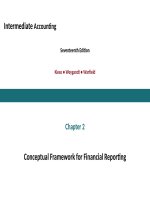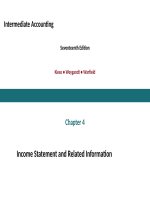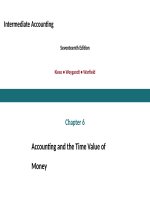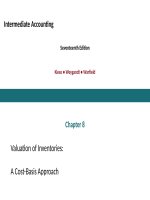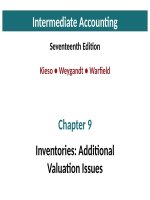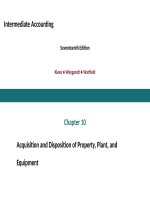Intermediate accounting 17e by kieso ch07
Bạn đang xem bản rút gọn của tài liệu. Xem và tải ngay bản đầy đủ của tài liệu tại đây (1.99 MB, 127 trang )
Intermediate Accounting
Seventeenth Edition
Kieso ● Weygandt ● Warfield
Chapter 7
Cash and Receivables
This slide deck contains animations. Please disable animations if
they cause issues with your device.
Learning Objectives
After studying this chapter, you should be able to:
1. Indicate how to report cash and related items.
2. Define receivables and explain accounting issues related to
their recognition.
3. Explain accounting issues related to valuation of accounts
receivable.
4. Explain accounting issues related to recognition and
valuation of notes receivable.
5. Explain additional accounting issues related to accounts
and notes receivable.
Copyright ©2019 John Wiley & Sons, Inc.
2
Preview of Chapter 7
Cash and Receivables
Cash
• Reporting cash
• Summary of cash-related items
Receivables
• Recognition of accounts receivable
• Measurement
• Variable consideration
Copyright ©2019 John Wiley & Sons, Inc.
3
Preview of Chapter 7
Valuation of Accounts Receivable
• Direct write-off method
• Allowance method
Notes Receivable
• Recognition of notes receivable
• Valuation of notes receivable
Copyright ©2019 John Wiley & Sons, Inc.
4
Preview of Chapter 7
Other Issues
• Fair value option
• Disposition of accounts and notes receivable
• Presentation and analysis
Copyright ©2019 John Wiley & Sons, Inc.
5
Learning Objective 1
Indicate How to Report Cash and
Related Items
LO 1
Copyright ©2019 John Wiley & Sons, Inc.
6
Cash
• Most liquid asset
• Standard medium of exchange
• Basis for measuring and accounting for all items
• Current asset
• Examples: Coin, currency, available funds on deposit
at the bank, money orders, certified checks, cashier’s
checks, personal checks, bank drafts and savings
accounts
LO 1
Copyright ©2019 John Wiley & Sons, Inc.
7
Cash
Reporting Cash
Cash Equivalents
Short-term, highly liquid investments that are both
(a) readily convertible to cash, and
(b) so near their maturity that they present
insignificant risk of changes in value.
Examples: Treasury bills, Commercial paper, and Money
market funds.
LO 1
Copyright ©2019 John Wiley & Sons, Inc.
8
Reporting Cash
Restricted Cash
Companies segregate restricted cash from “regular” cash.
Examples, restricted for:
(1) plant expansion, (2) retirement of long-term debt, and
(3) compensating balances.
LO 1
Copyright ©2019 John Wiley & Sons, Inc.
9
Reporting Cash
Bank Overdrafts
Company writes a check for more than the amount in its
cash account.
• Reported as a current liability
• Offset against other cash accounts only when
accounts are with the same bank
LO 1
Copyright ©2019 John Wiley & Sons, Inc.
10
Summary of Cash-Related Items
Classification of Cash-Related Items
Item
Cash
Classification
Cash
Comment
If unrestricted, report as cash.
If restricted, identify and classify
as current and noncurrent assets.
Petty cash and change funds Cash
Report as cash.
Short-term paper
Cash equivalents
Investments with maturity of less
than 3 months, often combined
with cash.
Short-term paper
Temporary investments Investments with maturity of 3 to
12 months.
Postdated checks and lOU's
Receivables
LO 1
Assumed to be collectible.
Copyright ©2019 John Wiley & Sons, Inc.
11
Summary of Cash-Related Items
Classification of Cash-Related Items (continued)
Item
Travel advances
Classification
Receivables
Postage on hand (as stamps
or in postage meters)
Bank overdrafts
Prepaid expenses
Compensating balances
Cash separately
classified as a deposit
maintained as
compensating balance
LO 1
Current liability
Comment
Assumed to be collected from
employees or deducted from
their salaries.
May also be classified as office
supplies inventory.
If right of offset exists, reduce
cash.
Classify as current or noncurrent
in the balance sheet. Disclose
separately in notes details of the
arrangement.
Copyright ©2019 John Wiley & Sons, Inc.
12
Learning Objective 2
Define Receivables and Explain
Accounting Issues Related to Their
Recognition
LO 2
Copyright ©2019 John Wiley & Sons, Inc.
13
Receivables
Claims held against customers and others for money,
goods, or services.
Classified in the balance sheet as:
• Current or noncurrent
• Trade or nontrade
LO 2
Accounts receivable
Notes receivable
Copyright ©2019 John Wiley & Sons, Inc.
14
Nontrade Receivables
1.
2.
3.
4.
Advances to officers and employees.
Advances to subsidiaries.
Deposits paid to cover potential damages or losses.
Deposits paid as a guarantee of performance or
payment.
5. Dividends and interest receivable.
6. Claims against: Insurance companies for casualties
sustained; defendants under suit; governmental bodies
for tax refunds; common carriers for damaged or lost
goods; creditors for returned, damaged, or lost goods;
customers for returnable items (crates, containers, etc.).
LO 2
Copyright ©2019 John Wiley & Sons, Inc.
15
Nontrade Receivables
Receivables Balance Sheet Presentations
LO 2
Copyright ©2019 John Wiley & Sons, Inc.
16
Recognition of Accounts Receivables
• Accounts receivable generally arise as part of a
revenue arrangement
• Revenue recognition principle indicates that a
company should recognize revenue when it satisfies
its performance obligation by transferring the good
or service to the customer.
LO 2
Copyright ©2019 John Wiley & Sons, Inc.
17
Recognition of Accounts Receivables
Illustration
If Lululemon sells a yoga outfit to Jennifer Burian for $100 on
account, the yoga outfit is transferred when Jennifer obtains
control of this outfit. When this change in control occurs,
Lululemon should recognize an account receivable and sales
revenue. Lululemon makes the following entry:
Accounts Receivable
100
Sales Revenue
LO 2
Copyright ©2019 John Wiley & Sons, Inc.
100
18
Recognition of Accounts Receivables
Key indicators control has been transferred
1. Lululemon has the right to payment from the
customer.
2. Lululemon has passed legal title to the customer.
3. Lululemon has transferred physical possession of the
goods.
4. Lululemon no longer has significant risks and
rewards of ownership of the goods.
5. Jennifer has accepted the asset.
LO 2
Copyright ©2019 John Wiley & Sons, Inc.
19
Receivables
Measurement of the Transaction Price
The transaction price is the amount of consideration that
a company expects to receive from a customer in
exchange for transferring goods or services.
Variable Consideration
In some cases the price of a good or service is dependent
on future events. These future events often include such
items as discounts, returns and allowances, rebates, and
performance bonuses.
LO 2
Copyright ©2019 John Wiley & Sons, Inc.
20
Variable Consideration
Trade Discounts
• Reductions from the list
price
• Not recognized in the
accounting records
• Customers are billed net
of discounts
LO 2
Copyright ©2019 John Wiley & Sons, Inc.
21
Variable Consideration
Cash Discounts (Sales Discounts)
• Offered to induce prompt
payment
• Presented in terms
2/10, n/30
2/10, E.O.M.,
net 30, E.O.M.
• Gross Method vs. Net
Method
LO 2
Copyright ©2019 John Wiley & Sons, Inc.
22
Cash Discounts (Sales Discounts)
LO 2
Copyright ©2019 John Wiley & Sons, Inc.
23
Cash Discounts (Sales Discounts)
Gross Method
On June 3, Bolton Company sold to Arquette Company
merchandise having a sale price of $2,000 with terms of 2/10,
n/60, f.o.b. shipping point. On June 12, the company received a
check for the balance due from Arquette Company. Prepare the
journal entries on Bolton Company books to record the sale.
June 3
Accounts Receivable
Sales
June 12 Cash ($2,000 × 98%)
Sales Discounts
Accounts Receivable
LO 2
Copyright ©2019 John Wiley & Sons, Inc.
2,000
2,000
1,960
40
2,000
24
Cash Discounts (Sales Discounts)
Net Method
On June 3, Bolton Company sold to Arquette Company
merchandise having a sale price of $2,000 with terms of 2/10,
n/60, f.o.b. shipping point. On June 12, the company received a
check for the balance due from Arquette Company. Prepare the
journal entries on Bolton Company books to record the sale.
June 3
Accounts Receivable
Sales
1,960
June 12 Cash ($2,000 × 98%)
1,960
Accounts Receivable
LO 2
Copyright ©2019 John Wiley & Sons, Inc.
1,960
1,960
25
